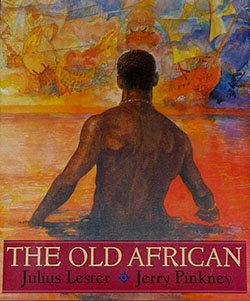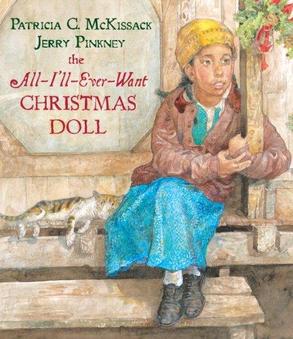A moral is a message that is conveyed or a lesson to be learned from a story or event. The moral may be left to the hearer, reader, or viewer to determine for themselves, or may be explicitly encapsulated in a maxim. A moral is a lesson in a story or in real life.

"The Tortoise and the Hare" is one of Aesop's Fables and is numbered 226 in the Perry Index. The account of a race between unequal partners has attracted conflicting interpretations. The fable itself is a variant of a common folktale theme in which ingenuity and trickery are employed to overcome a stronger opponent.

Jerry Pinkney was an American illustrator and writer of children's literature. Pinkney illustrated over 100 books since 1964, including picture books, nonfiction titles and novels. Pinkney's works addressed diverse themes and were usually done in watercolors.

The Lion & the Mouse is a 2009 nearly wordless picture book illustrated by Jerry Pinkney. This book, published by Little, Brown and Company, tells Aesop's fable of The Lion and the Mouse. In the story, a mouse's life is a spared by a lion. Later, after the lion is trapped, the mouse is able to set the lion free. Adapting the fable, with the moral that the weak can help the strong, as a wordless picture book was seen as a successful way of overcoming the brief plot generally found in the source stories. While it was Pinkney's first wordless picture book, it was not the first time he had told the story, having previously included it in his Aesop's Fables, published in 2000. Pinkney, who had received five Caldecott Honors, became the first African American to win the Caldecott Medal for his illustrations in this book. His illustrations were generally praised for their realism and sense of place. The cover illustrations, featuring the title characters but no text, drew particular praise.
The Tortoise and the Hare is one of Aesop's Fables.

Little Red Riding Hood is a 2007 children's picture book of the Brothers Grimm classic fairy tale adapted by Jerry Pinkney.

Minty: A Story of Young Harriet Tubman is a 1996 children's picture book by Alan Schroeder and is illustrated by Jerry Pinkney. Released in 1996 by Dial Press, it is a fictionalized story of Harriet Tubman as a young girl.

The Little Match Girl is a 1999 adaptation of the classic Hans Christian Andersen story by Jerry Pinkney. It is about a girl who is a street vendor of artificial flowers and matches in a city during the early twentieth century and rather than returning home, as she hasn't made any sales, lights her matches to keep warm, sees wonderful visions, then dies and goes to heaven.

Journeys with Elijah: Eight Tales of the Prophet is a 1999 children's picture book by Barbara Diamond Goldin and illustrated by Jerry Pinkney. It is based on the tradition that the biblical prophet Elijah can reappear to anyone anywhere at any time and is eight stories of people's encounters with him from ancient times to the modern day throughout the world.

Aesop's Fables is a 2000 collection of 61 fables from the Aesop oeuvre, retold by Jerry Pinkney. It includes stories about wolves, foxes, lions, dogs, mice, and donkeys.

The Little Red Hen is a 2006 book by Jerry Pinkney of the classic folktale about a chicken and some animals that decline to assist her in the growing and harvesting of wheat which she then uses to bake bread. When the animals ask to have some, she refuses and instead eats the bread with her chicks.

The Old African is a 2005 book by Julius Lester and illustrated by Jerry Pinkney. It is based on an incident at Igbo Landing and is about Jaja, a slave who leads a group of plantation slaves back to Africa by walking into the ocean.

Sweethearts of Rhythm is a 2009 book by Marilyn Nelson and illustrated by Jerry Pinkney, published by Dial Books for Young Readers. It is about various musical instruments in a pawnshop poetically reminiscing about the jazz band, International Sweethearts of Rhythm.

The Grasshopper & the Ants, by Jerry Pinkney, is a 2015 adaptation of the classic Aesop fable where a grasshopper relaxes through Spring, Summer, and Autumn, while a colony of ants work at gathering food for the Winter, but although initially refusing the grasshopper's request for help, they relent and invite him in to share.

The Hired Hand: An African-American Folktale is a 1997 book by Robert D. San Souci and illustrator Jerry Pinkney based on an African American folktale about an itinerant worker who is able to rejuvenate and resurrect people.

Albidaro and the Mischievous Dream is a 2000 book by Julius Lester and illustrator Jerry Pinkney telling why teddy bears look as if they have a secret.

The All-I'll-Ever-Want Christmas Doll is a 2007 picture book by Patricia McKissack and illustrated by Jerry Pinkney. It is about a girl, Nella, living during the Great Depression who amazingly receives a doll for Christmas, initially doesn't share with her sisters but then relents after discovering that it's not fun to play by herself.

The Christmas Boot is a 2016 picture book by Lisa Wheeler and illustrator Jerry Pinkney. It is about a woman, Hannah Greyweather, who finds a single black boot, that turns out to be owned by Santa.

Rikki-Tikki-Tavi is a 1997 retelling of Rudyard Kipling's classic story by Jerry Pinkney about a mongoose that protects a family from two cobras. The book won a Caldecott honor in 1998 for its illustrations.

Bruh Rabbit and the Tar Baby Girl is a 2003 picture book by Virginia Hamilton and illustrated by James Ransome. It is a retelling by Hamilton, in the Gullah dialect, of the classic story of Bruh Rabbit outwitting Bruh Wolf.


















